Here are a variety of different wax models for you to inspect. These
models, with the exception of one, are all O Scale (1:48). All of these
models went on to be cast in brass, several into production castings.

These wheels were made for a prominent ATSF and SP modeler in the San Jose area to replace sand-cast wheels on a KTM engine. Original wheels on the ATSF 2-10-4 were 74” in diameter, these were scaled to be 72” in diameter to allow for a 2” O Scale flange on the tires. The relief on these wheels was incredible, to a point where the caster had real trouble with voids on the spokes.
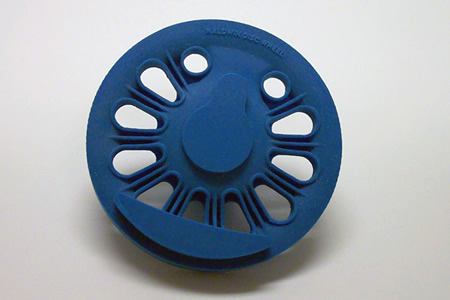
Here is one of the ATSF Texas Baldwin disks. If you look very closely, you can read the lettering on the wheel, which reads “Baldwin Disk Wheel.”

Here are two sizes of counterweights of Baldwin Disks for a PRR K-4s
locomotive. These were 80” wheels, and being that Precision Scale
made the center-to-center of the axles prototypical, we can put 80”
scale tires on these wheels even with a 2” O Scale flange. If
you look real close, you can see the lettering on the wheels. These
were late replacements on a K-4s locomotives.

Here are two wheels for a C&O F-17 Pacific locomotive. These are a special type of Commonwealth Boxpok made specifically for the C&O. Notice that the four big holes in each driver have a different shape. Also, these wheels had extended crank pin bosses per the customer.
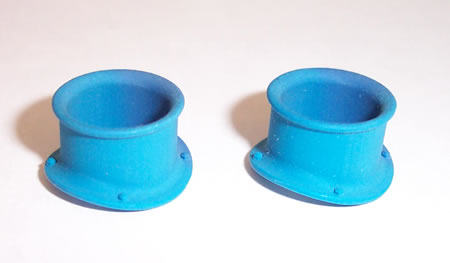
Here are two stacks (both the same) for a PRR I-1 2-10-0 locomotive. I can’t seem to find any printed data for these, but it appears when the I-1’s were shopped or rebuilt, they received larger stacks (as opposed to the K-4 type trumpet stack originally equipped.) Since the I-1 boiler was the predecessor of the M-1, and the M-1 had a huge stack, it makes sense rebuilt I-1’s would have larger stacks. These were scaled off of several prototypes.

Here are some wheels for a NYC J-3a Hudson 4-6-4 locomotive. These were to replace the original sand-cast wheels on a KTM model. These were made from customer-supplied prints of the real thing. The center wheel is the later heavy driver with large offset counterweight to alleviate track pounding. These were very difficult drivers to do, since each group of spokes had to be lofted into shape.
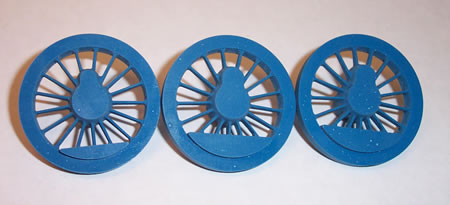
Here are three counterweight styles of later spoked wheels for a PRR K-4s locomotive. These can be used on anything from a Max Gray model to current models. These are the later heavy-hub type of spoked wheels, as opposed to the lighter web-style type of hub which first appeared on the K-4s wheels when it was produced.

Notice on this next picture of the K-4 wheels how the backsides of the counterweights are hollowed out. This keeps the model from loping down the track due to the increased mass of the counterweight (since the connecting rods on a model are not nearly as proportionally heavy as the real thing!) Also notice the extra material on the rim of the model and backside, to accommodate variations in the castings.

Here is a G Scale model for a D&RGW M-68 Northern stack. Notice the eight nuts with washers! The spud sticking out the left hand side was the sprue for the caster to attach to. It was determined it was easier to file the sprue off a convex outside surface than a concave inside one! Made for Doug Hemmeter of D&M Backshop in Houston, Texas.
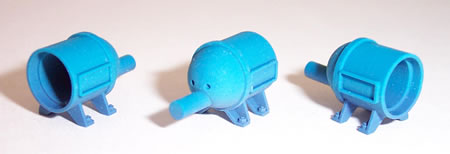
Here are three models (which will be attached to a common sprue when a rubber mold is made) of the late PRR modern headlight, the one that sits on the top of the smokebox. The spuds out the back of the models are for the casting sprue, and the dimples are 0.100” in width to be drilled out for a white LED (it’s easier to leave dimples in the model than cast the holes in.) It was elected to not hollow out the numberboards, as making a small plastic bezel to glue in would be a job.

Here are the three counterweight sizes for a PRR M-1 or M-1a Mountain locomotive. These were the late heavy-hub style of spoked wheels. These wheels are prototypically 72” in diameter, and both Westside and Overland has made the axles spacing correct in that it will take a 2” O Scale flange on a 72” tire.

Here are both styles of Union Web spoked wheels for a PRR K-4s locomotive. These were immediate replacements for the regular spoked type of wheel when the locomotive was shopped. Usually, the K-4s was run so hard, the spoked wheels would crack (down by the hub.) They were replaced with this style of wheel which had reinforcement on the spokes, especially in the crank-pin area.
Every variation of configuration between spoked, web-spoked and Baldwin disks were seen on the K-4s locomotive.

Here is a close up of the light counterweight of the Union Web spoke wheel center. It’s just a nice wheel, and model!
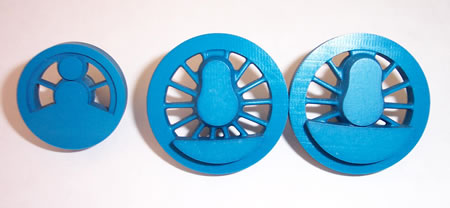
Here are wheel centers and the jackshaft for a Virginian E-3 Electric locomotive. This locomotive was similar to early Pennsylvania electrics in that the wheels were driven by siderods off a jackshaft, usually because the AC motors used in these electrics couldn’t fit down around the wheels. These were custom made for Dieter Boehme for an engine being custom-made by Stu Kleinschmidt. You’ll probably see it at a model contest here in the future!